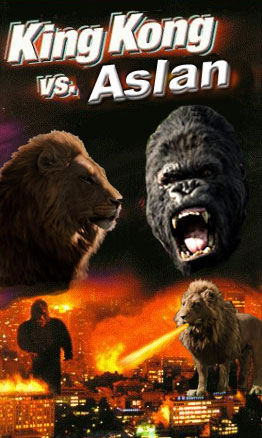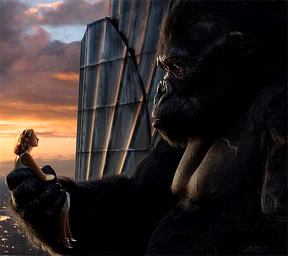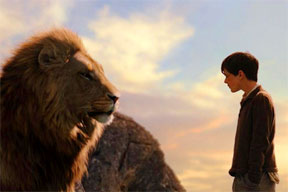| |
A Resource by Mark D. Roberts |
|
King Kong vs. Aslan
by Rev. Dr. Mark D. Roberts
Copyright © 2005 by Mark D. Roberts
Note: You may download this resource at no cost, for personal use or for use in a Christian ministry, as long as you are not publishing it for sale. All I ask is that you give credit where credit is due. For all other uses, please contact me at mark@markdroberts.com . Thank you.
King Kong vs. Aslan, Part 1 
Part 1 of the series: King Kong vs. Aslan 
Posted for Monday, December 19, 2005
I saw a movie on Friday. Here's the basic plot:
Some people travel to a mysterious land where they find strange beasts and unsought for adventures. This land is ruled by an awesome animal, whose kingly roar is deafening and who instills awe in the creatures of the land. When one member of the party is taken captive, the others seek to rescue that person, even though they'd rather just go home. As they are looking for their captured colleague, the rescue party is chased by ferocious beasts, who almost kill them. Ultimately, the captured person is saved from certain death by the sacrificial intervention of the animal king. Thereafter the captive, now rescued, feels a strong connection to the savior beast. Yet because of this captive, the great animal ends up losing his life.
So here's your quiz: What movie did I see on Friday?
You might be inclined to say The Lion, the Witch, and the Wardrobe. If you've been reading my blog recently, you know that I saw this movie over a week ago. Of course I could have seen it again. In fact, however, I didn't catch the Narnia film again. Instead, I plunked down $9.00 to see King Kong. |
|
|
The thematic similarities between The Lion, the Witch, and the Wardrobe and King Kong didn't occur to me until after I finished watching King Kong. During the movie I found myself making special effects comparisons. Both films must have used massive amounts of computer power to bring so many magical beings to life, most of all Aslan and King Kong. If I were voting for a special effects award, I'd give the nod to King Kong, though only by a computer-generated hair. The combination of computers and Andy Serkis (who played Kong, and who also played Gollum in The Lord of the Rings) is brilliant, especially when it comes to Kong's facial expressions. Serkis, who studied actual wild gorillas in Rwanda to prepare for his role, wore 132 sensors on his face to make Kong's facial expressions.
Though there are many similarities between the Narnia film and King Kong, the differences between them are legion. One is a spiritually-infused and not-quite-allegorical fantasy; the other is an action-adventure movie with a love story subplot (actually, a love stories subplot). One movie left me inspired and hopeful; the other left me feeling worn out and wistful.
As I mentioned earlier, Aslan and Kong have several things in common. Both are larger than life animals who rule as king within their respective domains. Both are strong, in body, will, and roaring power. Both have a sort of sadness about them, as if they've seen life's difficulties and know that things are never easy. Both have a playful streak, though the Narnia movie, to its detriment, doesn't develop this as much as the book does.
Differences Between Aslan and Kong
Yet Aslan and Kong are also very different in crucial ways, and these differences highlight the distinctive nobility of Aslan. For one thing, Aslan is truly and fully good. He only kills that which is evil. Kong, on the contrary, kills human beings without regard to their moral character. Though not shown on screen, Kong apparently eats victims who are sacrificed to him. Conversely, Aslan sacrifices himself for the sake of another.
Both Kong and Aslan are kings of their worlds. Yet the nature and source of their authority differ widely. Kong rules because of his sheer physical power and fearsome will. He can take on three T-Rexes at once and still prevail. He forces the natives on Skull Island to build giant walls to protect themselves. And even then, they must offer sacrifices to appease Kong's appetite for domination.
Aslan, on the other hand, rules by virtue of his wisdom and moral superiority. Though he also has formidable physical strength, downplayed somewhat in the Narnia film, I think, this is not the source of Aslan's authority. Rather, his subjects submit to him out of loving respect and reverence, not out of fear of being devoured. Human beings who seek goodness are drawn to Aslan, rather than fleeing from him, as they would from Kong.
Kong lovers, and I must confess to being in this club since I was a boy, should beware the temptation of romanticizing the giant ape. I can imagine someone saying, "Oh, if human society had only left Kong alone, then all would be well. The villain in King Kong is modern civilization, with its skyscrapers and guns." Yet this overlooks the fact that before he was disturbed by Carl Denham's wild goose chase, Kong ruled over people with violent strength and crippling fear. And, every now and then, he'd eat some of them. Kong would surely have been better off had he never met the likes of Carl Denham and Ann Darrow, but he was never a paragon of virtue.
Yet, one might object, didn't Kong save Ann Darrow from the dinosaurs? Didn't he protect her? Didn't he love her? I'll respond to these questions in my next post, as I address the nature of love in King Kong and The Chronicles of Narnia.
The Love of Kong 
Part 2 of the series: King Kong vs. Aslan 
Posted for Tuesday, December 20, 2005
Although the movie King Kong is most of all an adventure/action film, it is also a love story. Or, as I mentioned in my last post, it's really two love stories. On a human level, the movie tells the story of the growing love between Ann Darrow, a stunning young actress, and Jack Driscoll, a playwright who gets tricked into joining the fateful voyage to Skull Island. Yet on a inter-species level, the movie explores the love between Ann Darrow and her simian suitor, King Kong.
Of course it's always tricky to speak of animals as loving others, be they animal or human. Some scientists have suggested that animals don't really feel love at all. What seems to be love is really the expression of instinct and self-interest. According to this view, my dog isn't really glad to see me. Rather, she's glad to see her food provider, which just happens to be me. As an animal lover, I'm inclined to believe that animals do love, after a fashion anyway.
Ironically, I would bring in C.S. Lewis as an expert witness for my side of this argument. Lewis, author of The Chronicles of Narnia and therefore the creator of Aslan, wrote many books and articles besides the Narnia series. One of his most influential books, The Four Loves, is a study of different kinds of love. The humblest kind, according to Lewis, is affection (or what the Greeks called storge [store-gay]). This love, Lewis writes, is "the love in which our experience seems to differ least from that of the animals" (p. 53). So as to avoid misunderstanding, Lewis immediately adds, "I do not on that account give it a lower value. Nothing in Man is either worse of better for being shared with the beasts" (p. 53). Affection, according to Lewis, "ignores even the barriers of species. We see it not only between dog and man but, more surprisingly, between dog and cat" (p. 54-55).
But, whether real animals feel some sort of love or not, when it comes to King Kong, reality has little to do with it. There's no question that Kong feels some sort of love for Ann Darrow, and that she, in return, loves Kong in a certain way. If you have any doubts about Kong's love for Ann, just look into deep, sad, effusive eyes. They tell a lover's story.
But, I wonder, a story of what kind of love?
We must beware of confusing Kong's love for Ann with her love for him. Ann seems genuinely concerned for Kong's well being. She does not yearn for relationship with Kong in the way he does for her. So, when she is escaping from Skull Island with Kong in hot pursuit, she urges Kong to go back. For Ann, life will be better if Kong stays where he belongs and if she returns to New York. Ann's love is benevolent, one might almost see it as a mirror of God's love, in that it seems to want nothing for itself other than what is best for the beloved. |
|
| |
Kong and Ann peer into each other's eyes in a quiet moment atop the Empire State Building.
|
The nobility of Ann's love for Kong, however, should not be projected onto the big guy. His love is of a different sort. If Kong had the ability to see what would be best for Ann, he would not have tried to kill her human lover, Jack Driscoll, when Driscoll tried to rescue Ann from Kong's clutches. The benevolent Kong would have realized that Ann would be best off returning to New York with a human being whose love she could be receive and return. Kong's love, far from being essential giving, is of a more needy sort.
But, you might object, Kong rescues Ann from grave danger and certain death, at considerable risk to his own well-being. Doesn't this constitute a giving, even a God-like love? Perhaps. Kong does rescue Ann Darrow, well-played by the running, screaming Naomi Watts, and in a sense could be called her savior. Yet at first he seems motivated mostly by the desire to have her, perhaps for dinner, though the film is a little vague on this score. Latter Kong values Ann as a source of entertainment. He appears to like her vaudeville act.
As the film progresses, Kong does seem to develop what could be called, minimally, an affection for Ann Darrow. Yet at some points this affection seems to enter another dimension, perhaps what C.S. Lewis would call "friendship." In speaking of friendship in The Four Loves, Lewis does not refer to what we might call casual friendship, but rather to a deep bonding that comes from some profound commonality. True friendship is based, according to Lewis, not so much on something seen in the other as it is on some shared vision between the two parties. Quoting Emerson, Lewis writes, "Do you love me? means Do you see the same truth?" (p. 97) Hence, Lewis adds, "we picture lovers face to face but Friends side by side; their eyes look ahead" (p. 98). Perhaps the most poignant moment between Ann and Kong occurs, not as they are staring into each other's eyes, but as they are sitting together enjoying the beauty of nature. Their bond, it seems, is rooted in some mystical aesthetic union, like that of friends.
Finally, Kong seems to have a love for Ann that might best be called "erotic." By "erotic" I don't mean sexual, but rather a love that borders on worship or obsession. (Curiously, Peter Jackson's King Kong downplays the sexual dimension of the relationship between Ann and Kong that is present in the original movie.) One who feels erotic love desires the beloved, even at great personal risk. This seems to describe King Kong to a T.
This last paragraph was inspired by C. S. Lewis's discussion of eros in The Four Loves. There he writes:
Now Eros makes a man really want, not a woman, but one particular woman. In some mysterious but quite indisputable fashion the lover desires the Beloved herself, not the pleasure she can give. (p. 135)
Replace "a man" with "Kong" and you've got a fine description of the movie.
Later, Lewis adds:
For it is the very mark of Eros that when he is in us we had rather share unhappiness with the Beloved than be happy on any other terms. . . . Even when it becomes clear beyond all evasion that marriage with the Beloved cannot possibly lead to happiness . . . . Better to be miserable with her than happy without her.
What better description of Kong's passion for Ann Darrow? His attraction to her beauty leads him to being miserable, and, finally, to death itself. Although King Kong ends with the observation, "It wasn't the airplanes. It was beauty killed the beast," in truth it might have been said, "It wasn't the airplanes. It was Eros killed the beast."
King Kong's love for Ann Darrow has aspects of affection, friendship, and Eros, three of the four loves in Lewis's division. What it lacks, I would argue, is agape, or God-like love. This stands in stark contrast to the love of Aslan, the lion king of Narnia. In tomorrow's post I'll examine in greater depth the nature of Aslan's love and how this differs from that of Kong. The Lion, the Witch, and the Wardrobe could be called a love story, but of a very different sort from King Kong.
The Love of Aslan 
Part 3 of the series: King Kong vs. Aslan 
Posted for Wednesday, December 21, 2005
In my last post I examined the love of King Kong, suggesting that his love for Ann Darrow has aspects of affection, friendship, and Eros. These kinds of love I borrowed, ironically enough, from C.S. Lewis's classic little book, The Four Loves. Yet it's obvious that I found in Kong only three of the four loves. What's missing? Charity, the giving love of God.
One of the problems we have with understanding The Four Loves is that Lewis's names for love are apt to be misunderstood by anyone who speaks contemporary English with an American accent. The word "erotic" connotes sexual expression, perhaps even illicit sexuality, as in the phrase "erotic movie." For Lewis, Eros is distinct from raw sexuality, which he calls Venus, though it is closely related to Venus. Similarly, when Lewis refers to charity as a kind of love, we're apt to envision throwing a few coins into the Salvation Army bucket (unless we're shopping at Target, which has banned the Salvation Army). This notion of charity misses Lewis's point by a mile.
Charity comes from the Latin word caritas, by way of the Old French charité. The Latin word means, in addition to "love," "costliness, dearness, or affection." Caritas takes on a particular meaning in light of the Latin translation of the Greek Bible, because it regularly stands in for the Greek word agape (pronounced ah-gáh-pay). Agape is, above all, the love of God, or, better yet, the love that is God (1 John 4:8).
What is the essence of God's love? Lewis lays this out in the very beginning of The Four Loves:
Divine Love is Gift-love. The Father gives all He is and has to the Son. The son gives himself back to the Father, and gives Himself to the world, and for the world to the Father, and thus gives the world (in Himself) back to the Father too. (p. 11)
None of these words is hard to understand, though together they convey deep truths that are difficult to comprehend and, indeed, ultimately beyond our limited ability of comprehension. Nevertheless, Lewis claims that the essence of God's love is giving. In this sense it is charity in a familiar sense. But God's love isn't about tossing a couple of coins in the human benevolence bucket. God's love gives all. It sacrifices all. It endures all.
Before I explain how this is the love of Aslan, I must respond to the one who wonders if Kong's love for Ann Darrow doesn't include an element of charity. After all, Kong saves Ann from certain death at the hands, well, the claws, of vicious, hungry dinosaurs. In the process, the great ape sustains a number of injuries. Doesn't this suggest at least a measure of self-giving love in Kong?
Perhaps. Though Kong's willingness to risk his well being for Ann's sake seems motivated less by a giving love for Ann than by his desire to have Ann for himself. One would be hard pressed to argue that Kong was fighting the dinosaurs so that Ann could be free to live the fullest possible life. On the contrary, he fought for Ann so that he might possess her. This is not agape. (I agree with Lewis, by the way, that other loves besides agape have value and beauty, even if agape is the most perfect of the loves and that in which the other loves find their own perfection.)
Aslan exemplifies agape. This should come as no surprise, of course, since Lewis intentionally models Aslan after Jesus Christ, the One who embodies God's love for humanity. The great lion's agapic love is highlighted by the extent to which his relationship with others seems not to have much of the other three loves. In the book version of The Lion, the Witch, and the Wardrobe, we catch a glimpse of Aslan's affection for Lucy and Susan as he frolics with them in a field, though this was underplayed in the movie. Yet in both writing and in film, Aslan seems more aloof than affectionate, much like a real king with real subjects. He isn't hanging out with the Narnian creatures because he likes their company. Rather, he's acting out his commitment to them. He's giving himself so they might be free and whole.
Aslan's love is about as far from Eros as a love could be, though I don't mean to imply that Aslan would be critical of erotic love. Lewis rightly explains that Eros focuses on the individual Beloved to the exclusion of all others. Aslan's love is broad, including all of Narnia, or at least all of that which is good in Narnia.
Aslan's agape is seen most of all in his willingness to die in the place of Edmund the traitor. Here there is no question of any other sort of love. Aslan has no comfortable affection for Edmund, nor are they friends. And Eros is completely absent from Aslan's concern for Edmund. Rather, Aslan loves Edmund with a perfectly giving love, one that leads him to give up his life for Edmund.
Aslan becomes a picture of God-love as he offers himself in place of Edmund. This is agape at its finest. Notice that Edmund has done nothing to deserve Aslan's love. It is given graciously. It is not a response to the recipient of agape, but flows from the heart of the giver. |
|
|
I can't end this post without making the obvious connection between Aslan and God. In 1 John 4:10-11 we read:
In this is love, not that we loved God but that he loved us and sent his Son to be the atoning sacrifice for our sins. Beloved, since God loved us so much, we also ought to love one another.
This is exactly what Lewis has portrayed so poignantly in The Lion, the Witch, and the Wardrobe. Aslan's love is seen in his sacrifice. And this, in turn, inspires love in others. After Edmund has been face to face with Aslan and has received his love, the boy will never be the same. He will become a man who loves. Moreover, Aslan calls Edmund's siblings to love their brother by forgiving him and accepting him back into their family without reprisal.
The love of Kong led to sacrifice, and then the movie was over. There was no Deeper Magic. The love of Aslan led to sacrifice, and it seemed as if all was lost. Yet in Narnia there was Deeper Magic. In self-giving love there was redeeming power. Such love even had the power to overcome death.
We live in both worlds, if you will, the world of Kong and the world of Narnia. Like Kong, we experience loves that lead to pain, loss, and even death. Yet, through Christ, we have also seen the Gift-love of God that enters into pain, loss, and death, and yet is not defeated by them. This is the love that leads to life. This is the love we receive from Christ, and that we seek to give away to others in imitation of Him.
Home
|







